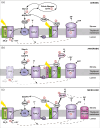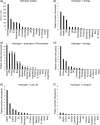Challenges and opportunities for hydrogen production from microalgae
- PMID: 26801871
- PMCID: PMC5066674
- DOI: 10.1111/pbi.12516
Challenges and opportunities for hydrogen production from microalgae
Abstract
The global population is predicted to increase from ~7.3 billion to over 9 billion people by 2050. Together with rising economic growth, this is forecast to result in a 50% increase in fuel demand, which will have to be met while reducing carbon dioxide (CO2 ) emissions by 50-80% to maintain social, political, energy and climate security. This tension between rising fuel demand and the requirement for rapid global decarbonization highlights the need to fast-track the coordinated development and deployment of efficient cost-effective renewable technologies for the production of CO2 neutral energy. Currently, only 20% of global energy is provided as electricity, while 80% is provided as fuel. Hydrogen (H2 ) is the most advanced CO2 -free fuel and provides a 'common' energy currency as it can be produced via a range of renewable technologies, including photovoltaic (PV), wind, wave and biological systems such as microalgae, to power the next generation of H2 fuel cells. Microalgae production systems for carbon-based fuel (oil and ethanol) are now at the demonstration scale. This review focuses on evaluating the potential of microalgal technologies for the commercial production of solar-driven H2 from water. It summarizes key global technology drivers, the potential and theoretical limits of microalgal H2 production systems, emerging strategies to engineer next-generation systems and how these fit into an evolving H2 economy.
Keywords: algae; fuel; hydrogen; renewable energy; solar; water.
© 2016 The Authors. Plant Biotechnology Journal published by Society for Experimental Biology and The Association of Applied Biologists and John Wiley & Sons Ltd.
Figures


Similar articles
-
Microalgal hydrogen production - A review.Bioresour Technol. 2017 Nov;243:1194-1206. doi: 10.1016/j.biortech.2017.07.085. Epub 2017 Jul 17. Bioresour Technol. 2017. PMID: 28774676 Review.
-
[Strategies for research and development and commercial production of microalgae bioenergy].Sheng Wu Gong Cheng Xue Bao. 2010 Jul;26(7):907-13. Sheng Wu Gong Cheng Xue Bao. 2010. PMID: 20954391 Review. Chinese.
-
Advances in the biotechnology of hydrogen production with the microalga Chlamydomonas reinhardtii.Crit Rev Biotechnol. 2015;35(4):485-96. doi: 10.3109/07388551.2014.900734. Epub 2014 Apr 22. Crit Rev Biotechnol. 2015. PMID: 24754449 Review.
-
Biohydrogen production from microalgal biomass: energy requirement, CO2 emissions and scale-up scenarios.Bioresour Technol. 2013 Sep;144:156-64. doi: 10.1016/j.biortech.2013.06.079. Epub 2013 Jun 27. Bioresour Technol. 2013. PMID: 23867534
-
Integration of microalgae cultivation with industrial waste remediation for biofuel and bioenergy production: opportunities and limitations.Photosynth Res. 2011 Sep;109(1-3):231-47. doi: 10.1007/s11120-011-9638-0. Epub 2011 Mar 9. Photosynth Res. 2011. PMID: 21461850 Review.
Cited by
-
Recent developments in synthetic biology and metabolic engineering in microalgae towards biofuel production.Biotechnol Biofuels. 2018 Jun 30;11:185. doi: 10.1186/s13068-018-1181-1. eCollection 2018. Biotechnol Biofuels. 2018. PMID: 29988523 Free PMC article. Review.
-
Perspective: Multiomics and Machine Learning Help Unleash the Alternative Food Potential of Microalgae.Adv Nutr. 2023 Jan;14(1):1-11. doi: 10.1016/j.advnut.2022.11.002. Epub 2022 Dec 23. Adv Nutr. 2023. PMID: 36811582 Free PMC article.
-
Designing a new generation of expression toolkits for engineering of green microalgae; robust production of human interleukin-2.Bioimpacts. 2020;10(4):259-268. doi: 10.34172/bi.2020.33. Epub 2020 Jul 13. Bioimpacts. 2020. PMID: 32983942 Free PMC article.
-
Genetic Engineering, Synthetic Biology and the Light Reactions of Photosynthesis.Plant Physiol. 2019 Mar;179(3):778-793. doi: 10.1104/pp.18.00360. Epub 2018 Jul 10. Plant Physiol. 2019. PMID: 29991483 Free PMC article. Review.
-
Microalgal Biorefinery Concepts' Developments for Biofuel and Bioproducts: Current Perspective and Bottlenecks.Int J Mol Sci. 2022 Feb 27;23(5):2623. doi: 10.3390/ijms23052623. Int J Mol Sci. 2022. PMID: 35269768 Free PMC article. Review.
References
-
- Antal, T.K. , Volgusheva, A.A. , Kukarskih, G.P. , Krendeleva, T.E. and Rubin, A.B. (2009) Relationships between H2 photoproduction and different electron transport pathways in sulfur‐deprived Chlamydomonas reinhardtii . Int. J. Hydrogen Energy, 34, 9087–9094.
-
- AREVA (2013) Renewable energies: AREVA inaugurates an energy storage platform in Corsica. http://www.areva.com/EN/news-9153/renewable-energies-areva-inaugurates-a... (accessed 29 October 2015).
-
- Baltz, A. , Kieu‐Van, D. , Beyly, A. , Auroy, P. , Richaud, P. , Cournac, L. and Peltier, G. (2014) Plastidial expression of type II NAD(P)H dehydrogenase increases the reducing state of plastoquinones and hydrogen photoproduction rate by the indirect pathway in Chlamydomonas reinhardtii . Plant Physiol. 165, 1344–1352. - PMC - PubMed
-
- Bandyopadhyay, A. , Stöckel, J. , Min, H. , Sherman, L.A. and Pakrasi, H.B. (2010) High rates of photobiological H2 production by a cyanobacterium under aerobic conditions. Nat. Commun. 1, 139. - PubMed
-
- Beckmann, J. , Lehr, F. , Finazzi, G. , Hankamer, B. , Posten, C. , Wobbe, L. and Kruse, O. (2009) Improvement of light to biomass conversion by de‐regulation of light‐harvesting protein translation in Chlamydomonas reinhardtii . J. Biotechnol. 142, 70–77. - PubMed
Publication types
MeSH terms
Substances
LinkOut - more resources
Full Text Sources
Other Literature Sources
Miscellaneous

